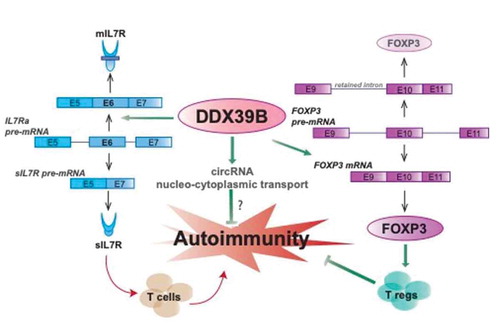Figures & data
Figure 1. MHC class III genes encoding RNA-binding proteins. A UCSC genome viewer schematic of the chromosome 6 region spanning the MHC class III region. Genes encoding proteins implicated in RNA metabolism are boxed in red. Genes encoding proteins with a potential role in RNA metabolism and mentioned in the text are boxed in green. Genes indicated in black correspond to proteins with an entry in the Protein Data Bank (PDB); genes indicated in dark blue represent transcripts that have been reviewed or validated by either the Reference Sequence collection (RefSeq), SWISS-PROT or the Consensus Coding Sequence Project (CCDS); genes indicated in light blue correspond to non-RefSeq transcripts

Figure 2. DDX39B, a guardian of tolerance. (Left) DDX39B is a potent activator of IL7R exon 6, which leads to lower levels of sIL7R. Since sIL7R promotes autoimmunity, the effect of DDX39B is to decrease the tendency towards autoimmunity. (Centre) DDX39B mediates nucleocytoplasmic transport of circular RNAs, which repress innate immune and autoimmune reactions. (Right) DDX39B promotes expression of Forkhead Box P3 (FOXP3) by enhancing the splicing of weak introns. FOXP3 is a master regulator of the development and function of CD4+/CD25+ T regulatory (T reg) cells, which downregulate autoimmunity. Arrows indicate activation and bar-headed lines indicate repression, and green arrows or bar-headed lines indicate processes that promote tolerance and red arrows indicate processes that promote autoimmunity

